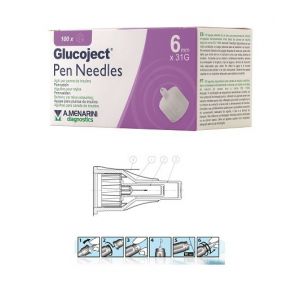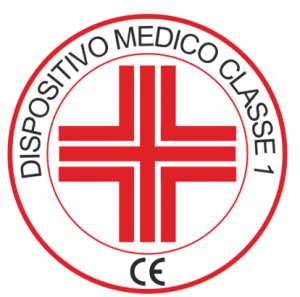Ship in Europe, Find out rates!
Language

Glucoject Insulin Pen Needle Length 6mm Gauge 31 100pcs
MENARINI
SKU
934512625
TAX DEDUCTIBLE
Italy
Special Price
€8.82
Regular Price
€23.50
Save... €14.68
-62%
Recent lowest price:
€8.15
In stock

Glucoject
Pen Needles
Insulin pen needles
PRODUCT IDENTIFICATION DATA
COMPLIANCE OF THE PRODUCT WITH THE APPLICABLE DIRECTIVES
GENERAL CHARACTERISTICS
INFORMATION ON THE REFERENCE CLASS
PACKAGING ON THE MARKET
All Glucoject Pen Needles can be used with all insulin pens according to ISO 11608
Pen Needles
Insulin pen needles
PRODUCT IDENTIFICATION DATA
| Commercial name | Glucoject Pen Needles |
| Manufacturer | HTL-STREFA SA, 95-035 Ozorkòw, 7 Adamòwek St., Poland. |
| Distributor | A.Menarini Diagnostics Florence - Italy |
| Internal Codes | 44029-44030-44031-44032-44033-46789 |
| CND code | A010199 - Needles for Insulin Pen |
| Year of placing on the market | 2014 |
COMPLIANCE OF THE PRODUCT WITH THE APPLICABLE DIRECTIVES
| European Directive 93/42 / EEC | Compliant - CE products (annex V + VII) |
| Classification | Class IIa |
| Notified entity | DEKRA |
GENERAL CHARACTERISTICS
INFORMATION ON THE REFERENCE CLASS
| General description of the product | Glucoject® Pen Needles are sterile, single-use needles for use in conjunction with injection pens for drug delivery into the body. Specifically, these are: - Highest quality needles - Thin wall technology - New method of lubrication - Screw-on application - 100% sterile - Six different versions of needle |
| Components | - Aug - Internal protective hood - External protective hood - Seal |
| Features | - Extremely sharp needle tip - Triple precision bevel - Special electropolishing - Super thin wall - Exclusive silicone lubrication |
| Technical drawing (figure 2) | 1) Needle complex 2) Cover needle 3) Protective cap 4) Seal |
| Dimensions | Length: 29.1mm Width: 16.5mm Depth: 16.8 mm |
| Use | Glucoject® Pen Needles are sterile, single-use needles for use in conjunction with injection pens for administering drugs into the body (usually insulin). |
| Reuse | Glucoject® Pen Needles are sterile and single use. Sterility is guaranteed if the needle seal is intact. Reuse can: - cause the needle to break; - cause lipohypertrophy; - damage the sharpness or can cause the tip to bend, causing bleeding, bruising or scarring; - increase the risk of breaking the needle in the skin; - increase the risk of infections as the needle is no longer sterile. |
| Method of use and mechanism of action (figure 3) | 1. Remove the seal from the needle. 2. Place the needle straight on the pen and screw it in until it is firm. Remove the outer protective cap and set it aside. You will need it later to remove the needle from the pen. Pull off the inner protective cap. 3. Set the insulin dose. 4. Check the flow by puncturing the air to release a small amount of liquid. A small drop should appear at the tip of the needle. 5. Perform the injection. 6. Replace the outer protective cap and remove the needle from the pen. |
| Insulin administration | - It is essential to choose a suitable place on the body to inject the insulin. - Insulin penetrates at different rates depending on the injection site. - It is recommended that insulin be injected in the same area for the therapy to give the best results, but the rotation of the injection points is important to avoid side effects. It is the doctor or healthcare professional who must recommend the most appropriate injection site. For example: - For fast-acting analogs and short-acting normal insulins, the abdomen is the best location. - For long-acting analogues and normal NPH insulins the best place is the thighs. - For premixed analogs and human mixed insulins the best locations are the abdomen and arm. |
| Period of validity | Validity is associated with the duration of infertility. Based on the tests carried out by the manufacturer HTL-STREFA SA, whose data are stored in accordance with the procedures of the Quality Management System, as required by the PN-EN ISO 13485 standard, a 3-year warranty is guaranteed. from the date of manufacture. |
| Recommendations | - Glucoject® Pen Needles allow the administration of insulin to adults, children and obese patients. - Obese people should use longer needles than thinner people. If a thin person uses a long needle there is a risk that it will hit the muscle tissue. - In general, if a heavy person uses a short needle the insulin can tend to disperse around the injection site, thus causing incorrect dosage. Pinching the skin before injecting the insulin helps avoid these problems, and it can be done by anyone. When it comes to pain, a thick needle can cause more pain than a thin one, but pain perception varies widely from person to person. - In the case of high insulin doses it is better to use a thicker needle. - It is also important to use an appropriate injection technique. - Insulin delivery techniques vary depending on the injection site and pen needle length. |
| Information on the components of the instrument | Components Materials Needle / cannula AISI 302 or 304 stainless steel Polypropylene container Polypropylene needle cover Polypropylene safety cap Patterned Lacquer seal Packaging box Corrugated cardboard |
| Sterilization | Gamma irradiation performed in accordance with PN-EN ISO 11137 |
| Further information | - Does not contain natural latex - Does not contain PVC - Does not contain phthalates |
PACKAGING ON THE MARKET
| Product code | Repertoire number | Commercial name | Specifications Depth x Caliber (mm x G) | Packaging |
| 44032 | 1195790 | Glucoject Pen Needles | 10mm x 29G | 100 pcs. |
| 44033 | 1195791 | Glucoject Pen Needles | 12mm x 29G | 100 pcs. |
| 46789 | 1195782 | Glucoject Pen Needles | 5mm x 31G | 100 pcs. |
| 44030 | 1195787 | Glucoject Pen Needles | 6mm x 31G | 100 pcs. |
| 44031 | 1195789 | Glucoject Pen Needles | 8mm x 31G | 100 pcs. |
| 44029 | 1195734 | Glucoject Pen Needles | 4mm x 32G | 100 pcs. |
All Glucoject Pen Needles can be used with all insulin pens according to ISO 11608
| Destination | Cost | Detail |
|---|---|---|
| Italy | €5,90* | 24/72H |
| Austria, France, Germany, Slovenia | € 13* | 3 days |
| Belgium, Luxembourg, Portugal, Netherlands, Spain | € 14* | 4 days |
| Bulgary, Cechia, Hungary, Poland, Romania, Slovakia | € 19* | 5 days |
| Denmark, Estonia, Finland, Ireland, Lithuania, Latvia ,Sweden | € 22* | 5 days |
| United Kingdom, Switzerland, Greece | € 30* | 7 days |
| Canada, USA | € 40 | 7 Days |
European shipments with express courier: FedEx, MBE, DHL
*For the shipment outside band B ther's an extra cost of 22€ *For the shipment outside band C ther's an extra cost of 30€ Delivery Times exclude Saturday and Holidays
For Islands and Areas of difficult Accessibility the shipments are made in 72 hours and the cost will be increased by 15€
The images of the products shown on our site are purely indicative and may differ in shape, color, text and packaging shown on them. Given the difficulty of updating all the products on our site in real time or any errors, XFarma.it, all products will be identified through SKU MINSAN (code of the Ministry of Health).
The transport of medicines sold online is carried out in compliance with the guidelines on good distribution practice according to Article 112-quater, paragraph 10. (Italy)